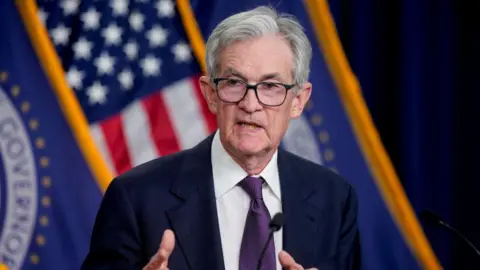 Getty Images
Getty ImagesThe US central bank has cut interest rates for a third time, despite concerns that the move will deliver a boost to the economy that risks reigniting inflation.
The decision was expected, setting the Federal Reserve’s key lending rate in a target range of 4.25% to 4.5%.
That is down a full percentage point since September, when the bank started lowering borrowing costs, citing progress stabilising prices and a desire to head off economic weakening.
Reports since then indicate that the number of jobs being created has been more resilient than expected, while price rises have continued to bubble.
Inflation, which measures the pace of price increases, stood at 2.7% in the US in November – up from 2.6% a month earlier.
Lower interest rates spur economic activity by making it easier to borrow. This can encourage businesses to invest or expand and households to spend on items such as cars. But if demand rises, higher prices typically follow.
Fed officials – who want to see inflation of about 2% – have said they are aware of the risks.
‘Closer call’
Bank chairman Jerome Powell defended the cut on Wednesday, pointing to cooling in the job market over the last two years.
But he conceded the move was a “closer call” and warned that officials were likely to lower rates less next year.
“We are in a new phase of the process,” he said at a press conference. “From this point forward, it’s appropriate to move cautiously and look for progress on inflation.”
Forecasts released by the Fed on Wednesday showed policymakers now expect the bank’s key lending rate to fall to just 3.9% by the end of 2025, higher than the 3.4% predicted just three months ago.
They also anticipate inflation staying higher next year than previously forecast, at about 2.5%.
John Ryding, chief economic advisor at Brean Capital, said he thought it would have been wiser for the Fed to hold off on a cut at this meeting, even if it risked upsetting markets expecting a reduction.
“There has been enormous progress made from the peak in inflation to where the US is now and it risks giving up on that progress, possibly even that progress being partially reversed,” he said. “The economy looks strong… What’s the rush?”
 Getty Images
Getty ImagesThe decision – formally opposed by one Fed policymaker – is the last by the central bank before president-elect Donald Trump takes office.
He won the election in November promising to bring down both prices and interest rates.
But analysts have warned that his policies, including plans to impose widespread import tariffs, could pose challenges to those goals.
The Fed’s announcement also comes a day before the Bank of England is due to make its latest interest rates decision in the UK, where price inflation has recently ticked higher.
It is widely expected to hold its benchmark rate steady at 4.75%.
Monica George Michail, associate economist at the National Institute of Economic and Social Research, said the Bank of England was facing rates of wage growth and price increases for services that are hotter than in the US.
Some of the government’s plans, which include hikes to the minimum wage, will also put pressure on inflation, she added.
“The Bank of England is trying to remain cautious,” she said.
But she warned that inflation risks are present in the US as well, pointing to Mr Trump’s tariff plans.
Mr Ryding said he thought the Bank of England – which unlike the Fed, does not have to consider unemployment as part of its mandate – was more clearly responding to the reality of the situation in front of it.
“The Bank [of England] is being more of a prudent central bank than the Fed is right now,” he said.
In the US, mortgage rates have actually climbed since September, reflecting bets that borrowing costs will stay relatively high.
Olu Sonola, head of US economic research at Fitch Ratings, said despite Wednesday’s cut, it felt like the Fed was signalling a “pause” as questions about White House policies make it more uncertain about the path ahead.
“Growth is still good, the labour market is still healthy, but inflationary storms are gathering,” he said.
